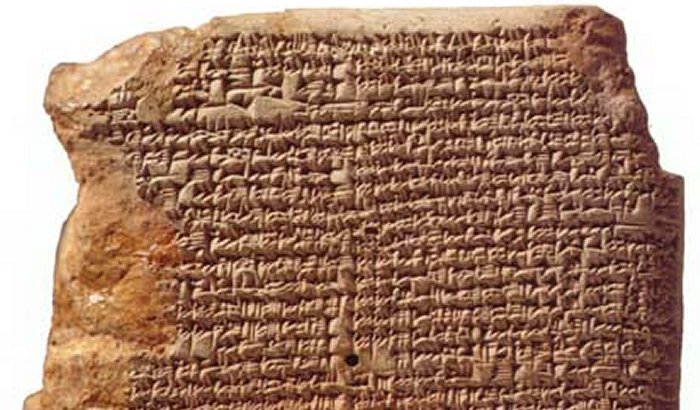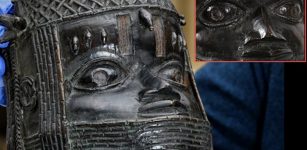MUL.APIN Tablets: Babylonian Knowledge Of Astronomy And Astrology Recorded In Cuneiform Writing
A. Sutherland - AncientPages.com - Systematic observations of the sky were carried out by Babylonians living in southern Mesopotamia in the middle of the third millennium BC.
 MUL.APIN, a Babylonian compendium that deals with many diverse aspects of Babylonian astronomy and astrology. source
MUL.APIN, a Babylonian compendium that deals with many diverse aspects of Babylonian astronomy and astrology. source
The result of these observations defined the concept of the ecliptic and its division into twelve parts, along which they placed twelve signs of the Zodiac. The MUL.APIN cuneiform tablets - the essential source of Babylonian astronomy - represent a set of ancient astronomical records that are believed to be forerunners of the present-day zodiac.
At the time of their introduction, they coincided with constellations with the same names. The tablets were created in Babylon around 687 BC and contained approximately 200 astronomical observations, including measurements related to several constellations.
Long-Lasting Debate On MUL.APIN Cuneiform Tablets
However, many archaeologists believe they are only transcriptions of much earlier records of astronomical observations made by Assyrian astronomers, who observed their sky about 2,300 BC.
The date of the origin of these observations has been disputed for a longer time.
The earliest copies were recovered from the royal library of the Assyrian King Assurbanipal (667-629 BC) in Nineveh and also from Assur.
Now, the majority of scholars believe that the MULAPIN text was originally compiled around 1000 BC, while the latest copies date back to around 300 BC.
The text on the tablets corresponds to the first constellation of the year, MULAPIN "The Plough," which is identified with the double star in the constellation of Andromeda, about 350 light-years from the Earth, known as Triangulum plus Gamma Andromedae. Today we can quickly locate these bright stars in the sky because they form the Big Dipper.
Further, the text lists the names of 66 stars and constellations and further gives a number of indications, such as rising, setting, and culmination dates, that help to map out the basic structure of the Babylonian star map.
When Bradley Schaefer, an astrophysicist at Louisiana State University in Baton Rouge, studied the MUL.APIN tablets, he calculated that the observations date back to 1,370 BC, give or take a century. The observations include the day each year that certain constellations first appeared in the dawn sky and were recorded in the region of Assur.
However, these dates change over the millennia because of a tiny wobble in the Earth's axis.
Small Tablets Of Great Importance
The text covers two MUL.APIN tablets, and possibly a third additional one, which still remains unrecovered.
The first tablet (8.4 centimeters high incised with miniature cuneiform) is the most important resource for any potential reconstruction of the Babylonian star map as its various sections locate the constellations in relation to each other and to the calendar.
All the major stars and constellations are listed and organized into three broad divisions according to celestial latitude assigning each star to three paths:
The first is the northern path of Enlil, containing 33 stars or constellations; the second is the equatorial path of Anu, containing 23 stars or constellations.
The third one is the southern path of Ea ("Whose House Is Water"), widely known as Enki, the Sumerian god of water, knowledge, mischief, crafts, creation, and one of the Anunnaki. The path of Enki contains 15 stars or constellations.
The heliacal rising dates of 34 stars and constellations are given according to the 360-day 'ideal' calendar year.
In the MUL.APIN tablets, an 'ideal' year composed of 12 'ideal' months, each of which was composed of an 'ideal' 30 days, even though the Babylonians used a lunisolar calendar, indicating both the Moon phase and the time of the solar year.
The second MUL.APIN tablet deals with the Babylonian methods and procedures to regulate the calendar and predict the movements of the sun, moon, and planets.
It is believed that there was also the third tablet (yet undiscovered=), and this one most probably explained celestial (astrological) omens.
Written by - A. Sutherland - AncientPages.com Senior Staff Writer
Copyright © AncientPages.com All rights reserved. This material may not be published, broadcast, rewritten or redistributed in whole or part without the express written permission of AncientPages.com
Expand for referencesReferences:
Hunger H. The Babylonian Astronomical Compendium MUL.APIN
Pannekoek A. A History of Astronomy
Rochberg F. Before Nature: Cuneiform Knowledge and the History of Science
More From Ancient Pages
-
 3,700-Year-Old Domed Oven Found At Troy Excavation Site Closely Related To Anatolian Culture
Archaeology | Sep 12, 2022
3,700-Year-Old Domed Oven Found At Troy Excavation Site Closely Related To Anatolian Culture
Archaeology | Sep 12, 2022 -
 Biblical City Of Tarsus: Excavations Reveal Its Secrets From Paul the Apostle’s Times
Archaeology | Jan 4, 2016
Biblical City Of Tarsus: Excavations Reveal Its Secrets From Paul the Apostle’s Times
Archaeology | Jan 4, 2016 -
 Top 5 Terrors Of The World’s Seas, Rivers And Lakes
Featured Stories | Mar 27, 2021
Top 5 Terrors Of The World’s Seas, Rivers And Lakes
Featured Stories | Mar 27, 2021 -
 Evolution Mystery – Mini-Proteins In Human Organs Appeared ‘From Nowhere’
Human Beginnings | Feb 20, 2023
Evolution Mystery – Mini-Proteins In Human Organs Appeared ‘From Nowhere’
Human Beginnings | Feb 20, 2023 -
 2,700-Year-Old Ceramic Sculpture Of Goddess Found In Aegean Sea
Archaeology | Feb 28, 2017
2,700-Year-Old Ceramic Sculpture Of Goddess Found In Aegean Sea
Archaeology | Feb 28, 2017 -
 Great Migrations Took Place In Poland And Ukraine In Bronze Age
Archaeology | Sep 8, 2023
Great Migrations Took Place In Poland And Ukraine In Bronze Age
Archaeology | Sep 8, 2023 -
 Face-To-Face Encounter With Young Scottish Soldier Who Lived And Died Over 300 Years Ago
Archaeology | Dec 23, 2017
Face-To-Face Encounter With Young Scottish Soldier Who Lived And Died Over 300 Years Ago
Archaeology | Dec 23, 2017 -
 Hispano-Visigothic Grave At Ojo Guareña – Resting Place Of A Hermit Who Sought Isolation When The Moors Arrived?
Archaeology | Sep 17, 2021
Hispano-Visigothic Grave At Ojo Guareña – Resting Place Of A Hermit Who Sought Isolation When The Moors Arrived?
Archaeology | Sep 17, 2021 -
 Benin Bronze Sculpture Looted By British Soldiers In Nigeria – Returns Home
Archaeology | Apr 2, 2021
Benin Bronze Sculpture Looted By British Soldiers In Nigeria – Returns Home
Archaeology | Apr 2, 2021 -
 Mysterious And Unexplained Encounter With Unusual Tiny Beings In Italy – The Thing – Part 1
Featured Stories | Jan 15, 2022
Mysterious And Unexplained Encounter With Unusual Tiny Beings In Italy – The Thing – Part 1
Featured Stories | Jan 15, 2022 -
 Were There Gladiators In Roman Britain? An Expert Reviews The Evidence
Featured Stories | Mar 14, 2023
Were There Gladiators In Roman Britain? An Expert Reviews The Evidence
Featured Stories | Mar 14, 2023 -
 Ancestral Home Of All Humans Revealed Through World’s Largest Genome Reconstruction Of Our Ancestors
Archaeology | Jan 3, 2023
Ancestral Home Of All Humans Revealed Through World’s Largest Genome Reconstruction Of Our Ancestors
Archaeology | Jan 3, 2023 -
 Ancient Intercontinental Underground Tunnels Built By Survivors Of A Great Catastrophe And The Snake God Connection
Ancient Mysteries | Jul 4, 2018
Ancient Intercontinental Underground Tunnels Built By Survivors Of A Great Catastrophe And The Snake God Connection
Ancient Mysteries | Jul 4, 2018 -
 Underground Civilizations – Secret Subterranean Corridors And Strange People – Part 2
Ancient Mysteries | May 10, 2019
Underground Civilizations – Secret Subterranean Corridors And Strange People – Part 2
Ancient Mysteries | May 10, 2019 -
 Connection Between Viruses And Ancestors Of All Complex Life Has Been Found
Archaeology | Jul 1, 2022
Connection Between Viruses And Ancestors Of All Complex Life Has Been Found
Archaeology | Jul 1, 2022 -
 On This Day In History: Battle Of Dormans Was Fought – On October 10, 1575
News | Oct 10, 2016
On This Day In History: Battle Of Dormans Was Fought – On October 10, 1575
News | Oct 10, 2016 -
 Celts: Facts And History About The Powerful And Intriguing People Of Central And Northern Europe
Civilizations | Aug 7, 2022
Celts: Facts And History About The Powerful And Intriguing People Of Central And Northern Europe
Civilizations | Aug 7, 2022 -
 Cursed Dudleytown – What Really Happened In America’s Village Of The Damned In Connecticut
Featured Stories | May 27, 2020
Cursed Dudleytown – What Really Happened In America’s Village Of The Damned In Connecticut
Featured Stories | May 27, 2020 -
 Crannogs – Artificial Islands In Scotland Are Older Than Stonehenge
Archaeology | Jun 17, 2019
Crannogs – Artificial Islands In Scotland Are Older Than Stonehenge
Archaeology | Jun 17, 2019 -
 Long-Lost Ancient Tomb Of ‘China’s Shakespeare’ Finally Found
Archaeology | Aug 31, 2017
Long-Lost Ancient Tomb Of ‘China’s Shakespeare’ Finally Found
Archaeology | Aug 31, 2017

